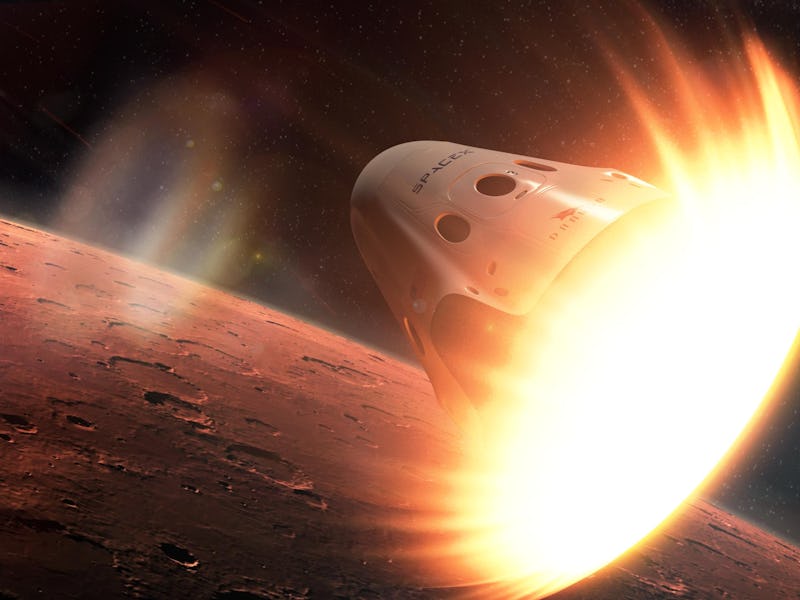Elon Musk Unveils SpaceX's Timeline for Sending People to Mars
Will we see humans on Mars by 2026?

SpaceX wants to get to Mars not just to plant a flag in the ground and call it a day but to establish a working, sustainable colony on the red planet. In a paper published recently in the journal New Space, SpaceX CEO Elon Musk offers some clearer details about how exactly he and his team intend to make an affordable transportation system to Mars possible — including a more concrete timeline for that journey.
“In 2002, SpaceX basically consisted of carpet and a mariachi band,” wrote Musk. “That was it. I thought we had maybe a 10 percent chance of doing anything—of even getting a rocket to orbit, let alone getting beyond that and taking Mars seriously.”
He wasn't kidding. There was actually a mariachi band.
The company has come a long way since then — 11 Falcon 9 rocket landings on Earth, reusing one of them, the development of a flagship spacecraft called Dragon, bouncing back from several failures (including two very devastating accidents), and a ton of other milestones, both good and bad. But all of SpaceX’s work is under the construction, testing, and establishment of the Interplanetary Transport System.
The SpaceX timeline for testing and launching the architecture which will take humans to Mars.
Here’s how Musk intends to make the ITS possible:
The Falcon Heavy rocket
September 2017: The Falcon Heavy Takes Off
The company’s heavy-lift rocket won’t be the one to take people to Mars en masse, but it will play a critical role in testing out the architecture necessary for deep space travel to the red planet, for both uncrewed and crewed missions. SpaceX is planning to hold a maiden launch of the Falcon Heavy for around September.
Red Dragon
2018 (Maybe??): Dragon 2 Takes Astronauts Out to Space
Dragon 2, also known as the Crew Dragon, is the crewed version of the Dragon capsule. SpaceX has been working on this baby for years as part of its contract with NASA to start taking U.S. astronauts into space, but the project has repeatedly run into delays. The most optimistic timeline for a crewed test launch of the vehicle is May 2018. Later that year, the company plans to send two people on a circumnavigational trip around the moon, so Dragon 2 really needs to be up and ready to work by next year.
2020: the Red Dragon Double Header
The Mars-bound version of the Red Dragon will finally take off the red planet in 2020, with not one but two missions during the launch window (when the orbits of Mars to Earth veer closest to one another and provide the shortest travel distance). Both missions will be uncrewed, but hey, they will be critical for proving SpaceX has the ability to actually send a spacecraft to Mars and land it safely on the surface.
These uncrewed missions will stretch out to around 2022-2023, with SpaceX looking to launch as many as possible during that timeframe.
2023: Flights to Mars Are Underway
Although Musk lists 2023 as the beginning of crewed flights to Mars, the most optimistic occurrence for seeing SpaceX astronauts land on the surface of the planet is around the 2025 launch window, putting a landing around 2026. Will SpaceX actually achieve such a monumental milestone? Will the company beat NASA to Mars? Those questions are still up in the air.
If history has been any indication so far, it is that it’s a good idea to bet on SpaceX, but perhaps a better idea is to bet against the company’s most bullish hopes and expectations.